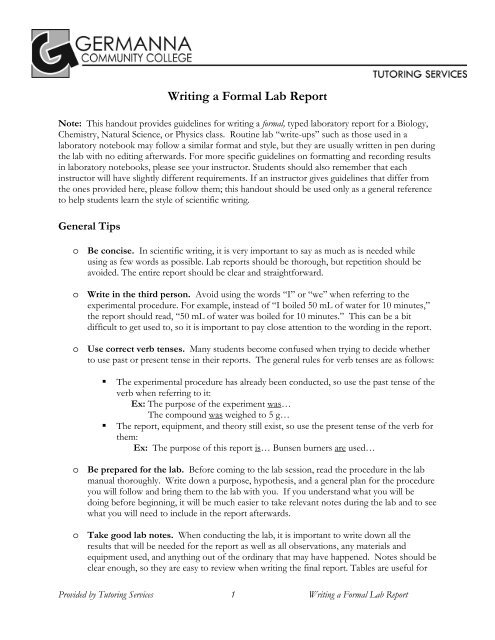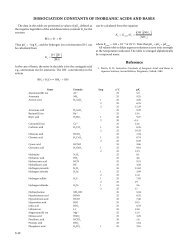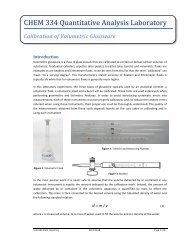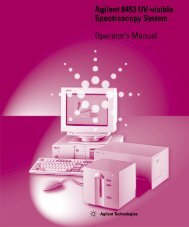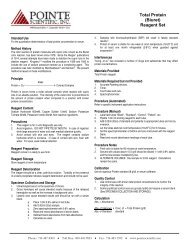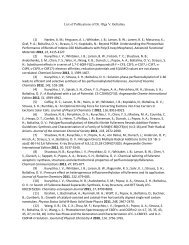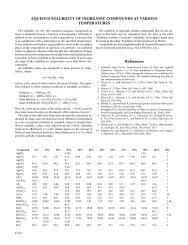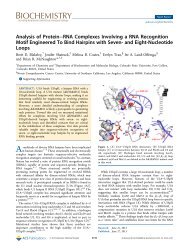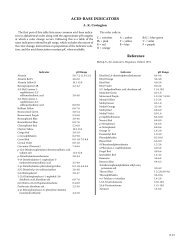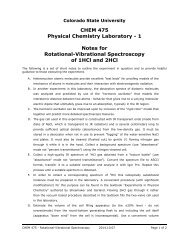Writing a Formal Lab Report
Writing a Formal Lab Report
Writing a Formal Lab Report
- No tags were found...
You also want an ePaper? Increase the reach of your titles
YUMPU automatically turns print PDFs into web optimized ePapers that Google loves.
<strong>Writing</strong> a <strong>Formal</strong> <strong>Lab</strong> <strong>Report</strong>Note: This handout provides guidelines for writing a formal, typed laboratory report for a Biology,Chemistry, Natural Science, or Physics class. Routine lab “write-ups” such as those used in alaboratory notebook may follow a similar format and style, but they are usually written in pen duringthe lab with no editing afterwards. For more specific guidelines on formatting and recording resultsin laboratory notebooks, please see your instructor. Students should also remember that eachinstructor will have slightly different requirements. If an instructor gives guidelines that differ fromthe ones provided here, please follow them; this handout should be used only as a general referenceto help students learn the style of scientific writing.General Tipso Be concise. In scientific writing, it is very important to say as much as is needed whileusing as few words as possible. <strong>Lab</strong> reports should be thorough, but repetition should beavoided. The entire report should be clear and straightforward.o Write in the third person. Avoid using the words “I” or “we” when referring to theexperimental procedure. For example, instead of “I boiled 50 mL of water for 10 minutes,”the report should read, “50 mL of water was boiled for 10 minutes.” This can be a bitdifficult to get used to, so it is important to pay close attention to the wording in the report.o Use correct verb tenses. Many students become confused when trying to decide whetherto use past or present tense in their reports. The general rules for verb tenses are as follows:• The experimental procedure has already been conducted, so use the past tense of theverb when referring to it:Ex: The purpose of the experiment was…The compound was weighed to 5 g…• The report, equipment, and theory still exist, so use the present tense of the verb forthem:Ex: The purpose of this report is… Bunsen burners are used…o Be prepared for the lab. Before coming to the lab session, read the procedure in the labmanual thoroughly. Write down a purpose, hypothesis, and a general plan for the procedureyou will follow and bring them to the lab with you. If you understand what you will bedoing before beginning, it will be much easier to take relevant notes during the lab and to seewhat you will need to include in the report afterwards.o Take good lab notes. When conducting the lab, it is important to write down all theresults that will be needed for the report as well as all observations, any materials andequipment used, and anything out of the ordinary that may have happened. Notes should beclear enough, so they are easy to review when writing the final report. Tables are useful forProvided by Tutoring Services 1 <strong>Writing</strong> a <strong>Formal</strong> <strong>Lab</strong> <strong>Report</strong>
1. Title Page2. Abstracto Number and title of the experiment• Ex: <strong>Lab</strong> #4: Isolation of Caffeine from Tea Leaveso Names of lab partnerso Date(s) on which the experiment was conductedThe report abstract is a short summary of the report. It should be no more than oneparagraph (100-200 words) and should include about one or two sentences on each of thefollowing main points:o Purpose of the experimento Key resultso Major points of discussiono Main conclusionsIt may help to complete the other sections of the report before writing the abstract, as thesefour main points can be drawn from them.3. IntroductionThis introduction is also often referred to as the ‘purpose’ or ‘plan’ section. It shouldinclude two main categories:o Purpose or objective of the experiment expressed clearly in only one or twosentences, including the main method used to accomplish the purpose.Ex: The purpose of the experiment was to determine the percentage by massof acetic acid in vinegar using acid/base titration.The purpose is also sometimes written as a separate section from the introduction.o Background and theory pertaining to the experiment. This can includeinformation from previous research, explanations of theories, methods or equationsused, etc.; for the example above, you might want to explain the theory behindacid/base titration and a brief description of the setup and process you will use in theexperiment. If research is done for this section, be sure to cite any sources usedaccording to the instructor’s preference. Be careful to include only the informationthat a reader would need to know in order to understand the purpose and methods;the report should still be as straightforward as possible.Provided by Tutoring Services 3 <strong>Writing</strong> a <strong>Formal</strong> <strong>Lab</strong> <strong>Report</strong>
In addition to the purpose and background information, the instructor may also ask studentsto provide the following items in the introduction section:o A hypothesis: what is expected to happen in the experiment based on backgroundinformation.o Safety information. This is especially useful in chemistry classes, where toxic orflammable chemicals are often used. The best resources for this safety informationare Material Safety Data Sheets (MSDS), which can be found in many locations onthe internet. One good place to find a wide variety of MSDS is atwww.flinnsci.com/search_msds.asp. On this page, you can search for an MSDSby typing the name of the chemical of interest into the search bar and clicking‘search.’ The sheet will contain a tremendous amount of information on the physicalproperties of the substance, first aid measures, and how the substance should behandled. In the report, summarize key safety information from the MSDS in a fewsentences if possible.Regardless of the specific information required from the instructor, the main focus of theintroduction should be on helping the reader to understand the purpose, methods, andreasons these particular methods are being used.4. Materials and MethodsThis is usually a simple listing of the equipment used in the form of a bulleted list, but itshould be complete and accurate. Graphics of more complex setups may also be included ifthey would be helpful.5. Experimental ProcedureThis section includes the process of the experiment exactly as it was done in the laboratory.Usually the procedure is written out in paragraph form, but it may also be written out stepby-stepin the form of a numbered list. Some instructors allow a citation to the lab manualfor this section (Ex: “The process in the laboratory manual for BIO 102 was used.”);however, if the lab manual is cited, any changes made to that procedure should be noted.There should not be any results (things that happened when the procedure was beingcarried out) included in this section; only include the procedures carried out. A good rule ofthumb for writing complete but concise experimental procedures is to include enoughinformation so that others who read the report would be able to duplicate the experiment ata later date.Provided by Tutoring Services 4 <strong>Writing</strong> a <strong>Formal</strong> <strong>Lab</strong> <strong>Report</strong>
6. ResultsThis section contains all the results of the experiment, including:o Raw data (weights, temperatures, etc.) organized into graphs or tables. Each graph,table, or figure should be labeled and titled properly. The key to making tables andfigures effective is to refer to and explain each one in the body of the paper.o Important results in verbal form. For the main results that will be expanded uponin the discussion section, use complete sentences (i.e. “The percentage of acetic acidin vinegar was calculated to be 4.982 %”). This will help the key results to stand outfrom all the calculations, tables, and figures that normally dominate the resultssection.o Calculations. Usually, only a sample of each calculation is needed. For example, ifthe percentage of acetic acid in 10 samples of vinegar has to be calculated and thenaveraged, write out the calculation for only one of them, then mention that thecalculation was repeated for 10 samples and give the average of all 10. Correctsignificant figures should be used in all calculations (see our “Significant FigureRules” handout for help with significant figures). Make sure units (cm., mL, etc.) areincluded in all calculations, and that major results of each calculation stand out fromthe rest of the numbers. This can be accomplished by typing the key numbers inboldface and by including them in a complete sentence as shown above.7. DiscussionThe discussion section is the most important part of the report. This is the section wherethe results are explained, and a student can show the instructor that he or she has a thoroughunderstanding of the concept of the experiment and the results obtained. The mainquestion to be addressed in this section is “What is the significance of the results?”Here are some strategies to help focus your discussion:o Compare expected results with actual results. If the experiment did not turn outexactly as expected, think about why the results might have been different and try toexplain why you got the results you did.o Analyze experimental error. There is a degree of error in every experiment, so everylab report should mention potential causes of error. Be specific about what caused theerror. Was it due to the equipment? Impurity of the sample? Errors in calculations?o Explain how the methods could be improved. Once you have decided what mighthave caused error, you should explain how the error might have been avoided. Howcould the setup be made more effective? Should you have been more careful withmeasurements? How could contamination have been prevented more effectively?Should more precise equipment be used?Provided by Tutoring Services 5 <strong>Writing</strong> a <strong>Formal</strong> <strong>Lab</strong> <strong>Report</strong>
o Explain the results in terms of the purpose. If the original purpose of theexperiment was achieved, explain how the results show that the purpose wasaccomplished. For example, if the purpose was to determine the percentage of aceticacid in vinegar, you could research the real percentage of acetic acid in most commercialvinegars and compare that to the calculated result from the experiment. A smalldifference would indicate that the percentage calculated was very close to the actualpercentage and the purpose was accomplished. If the purpose was not achieved, provethis by the results in a similar fashion.o Relate the results to those of other, similar experiments. Depending on the natureof the experiment and the instructor’s preferences, you may want to compare yourresults to those of the rest of the class. If your results were similar to the others’, thiscan be an indication that they were reasonably accurate. If they were very different,explain why they may have been different.8. ConclusionThis section includes only one or two sentences that summarize definitive conclusions fromthe results. Here is an example of a conclusion for the acetic acid experiment used in earlierexamples:From a comparison of the results of the experimental calculations with the normalvalue for percent acetic acid in vinegar, it can be concluded that the percentage ofacetic acid in the sample used in this experiment was about 4.982%.Notice how the conclusion relates directly to the main objective of finding the percentage ofacetic acid in the given sample of vinegar. The conclusion also justifies itself based on theresults; the actual results were comparable to the expected results. The degree of confidencethe writer has in the conclusion is also shown; the percentage was an average rather than anexact amount, so the word ‘about’ was used.9. References/AppendicesNot every instructor will require these sections, but if outside sources have been cited, areference list will be needed. If there is a significant amount of extra data or calculations, itmay be beneficial to put them into an appendix at the end of the report. As mentionedearlier, instructors will usually tell students how they want references formatted, but if aformat is not specified, APA citations should be used. For instructions on formattingreferences in the APA style, see the APA format handout under the English section on theTutoring Services’ web site: http://www.germanna.edu/tutor/helpful_handouts.aspProvided by Tutoring Services 6 <strong>Writing</strong> a <strong>Formal</strong> <strong>Lab</strong> <strong>Report</strong>


